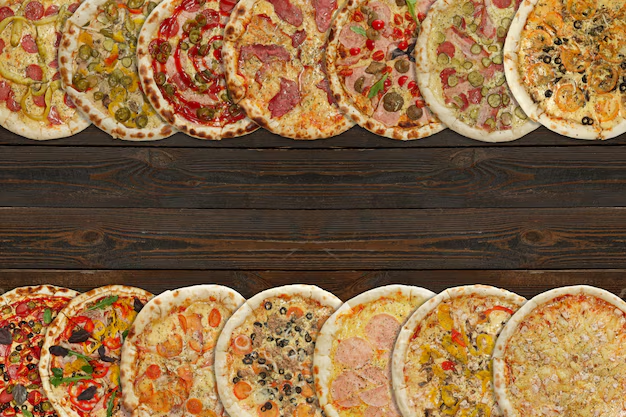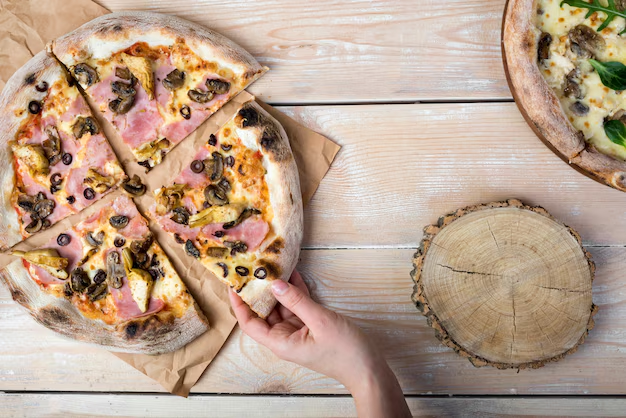Pizza is one of the most loved foods worldwide. Its irresistible combination of cheesy goodness, savory toppings, and crispy crust has universal appeal. But when it comes to health and nutrition, pizza often raises questions, especially about its carb content. For those watching their carb intake, it’s essential to understand how many carbs are in a slice of pizza.
The carb content in pizza varies depending on the crust type, size, and toppings. On average, a slice of regular crust pizza contains about 30-35 grams of carbs. Knowing these details can help you make better dietary decisions. In this guide, we’ll break down the carbs in various types of pizza and explore how you can still enjoy pizza on a low-carb diet.
Carbs in a Slice of Pizza: The Basics
Pizza is naturally high in carbs because its crust is made from flour, a carbohydrate-rich ingredient. The toppings, sauces, and even cheese can add small amounts of additional carbs. On average:
- A slice of regular crust pizza has 30-35 grams of carbs.
- Thin crust options have slightly fewer carbs.
- Deep-dish pizza has significantly more carbs due to its thicker crust.
Factors Affecting Carb Count
The number of carbs in pizza depends on several factors:
- Crust Type: Thin crusts have fewer carbs than regular or deep-dish crusts.
- Toppings: Meaty toppings like pepperoni or sausage have fewer carbs compared to sugary barbecue sauce or pineapple.
- Slice Size: Larger slices mean more carbs.
How Carbs in Pizza Are Calculated?
The main contributor to carbs in pizza is the crust, which is typically made from wheat flour. Other ingredients that add carbs include:
- Pizza Sauce: Contains sugar, adding 2-5 grams of carbs per slice.
- Cheese: Minimal carbs, usually less than 1 gram per slice.
- Vegetable Toppings: Add fiber and some carbs, but amounts are small.
Role of Serving Size
Serving size plays a big role. A larger slice from a 14-inch pizza will contain more carbs than a smaller slice from a 10-inch pizza.
Importance of the Crust
The crust is the most significant factor. Thin crusts reduce carb content, while thicker crusts like pan or deep-dish increase it. Gluten-free crusts may not always mean lower carbs, as they are often made with rice or potato flour.
Breakdown of Carbs in Different Types of Pizza

Regular Crust Pizza
A standard slice of pizza with regular crust is the most common type.
- Average carb count: 30-35 grams per slice.
- Example: A slice of pepperoni or cheese pizza typically falls within this range.
Thin Crust Pizza
Thin crust pizzas have less dough, which reduces their carb content.
- Average carb count: 20-25 grams per slice.
- Benefits: Ideal for low-carb eaters who still want to enjoy pizza.
- Best for those who prefer a crispier texture and lower calories.
Deep-Dish Pizza
Deep-dish or Chicago-style pizza is known for its thick, bready crust.
- Average carb count: 40-50 grams per slice.
- Why higher? The crust is thicker and often contains added fats or oils.
- Recommendation: This type of pizza is not ideal for low-carb diets.
Gluten-Free Pizza
Many assume gluten-free means low-carb, but that’s not always true.
- Gluten-free crusts are often made with alternative flours like rice, corn, or potato, which can still be carb-heavy.
- Average carb count: 20-30 grams per slice, depending on the brand.
- Best option: Look for keto-friendly gluten-free pizzas made with almond or coconut flour.
Specialty Pizzas
Dessert Pizzas
- Dessert pizzas, topped with ingredients like chocolate or fruit, have the highest carb count.
- Average carb count: 40-60 grams per slice.
Vegan and Vegetarian Pizzas
- Vegan pizzas use plant-based toppings, which can be high in carbs if loaded with starchy vegetables.
- Average carb count: 25-35 grams per slice, depending on the crust and toppings.
Is Pizza Compatible with Low-Carb or Keto Diets?
Traditional pizza isn’t ideal for keto or low-carb diets due to its high-carb crust. However, modifications can make pizza more diet-friendly.
Tips for Enjoying Pizza on a Low-Carb Plan
- Opt for Thin Crust: It reduces the carb count significantly.
- Choose Toppings Wisely: Stick to low-carb options like meats, cheese, and non-starchy vegetables.
- Skip Sugary Sauces: Avoid barbecue or sweet sauces.
Modifications to Reduce Carbs
- Cauliflower Crust: Made from ground cauliflower and cheese, this option can have as few as 5 grams of carbs per slice.
- Almond Flour Crust: Another low-carb alternative, offering about 6-8 grams of carbs per slice.
- Cheese Crust or “Crustless” Pizza: Some recipes use baked cheese as a base, creating a carb-free pizza option.
Nutritional Value of Pizza Beyond Carbs
Pizza offers more than just carbohydrates. It provides essential macronutrients and several key vitamins and minerals. Let’s explore what else pizza brings to your plate.

Macronutrients (Protein and Fat Content)
- Protein: Pizza is rich in protein, thanks to the cheese and toppings like meat. A regular slice contains around 12-15 grams of protein. Protein supports muscle repair and keeps you feeling full.
- Fats: Most of the fat in pizza comes from cheese and oils in the crust. A slice contains about 10-15 grams of fat. While some fats are healthy, excess saturated fats from processed meats or extra cheese should be consumed in moderation.
Key Vitamins and Minerals in Pizza
- Calcium: Cheese is an excellent source of calcium, which is vital for strong bones and teeth.
- Iron: Pizza crust and tomato sauce contribute iron, essential for oxygen transport in the blood.
- Vitamin C: Tomato sauce provides a small amount of Vitamin C, supporting immunity.
- Vitamin A: Cheese and certain toppings (like spinach) add Vitamin A for eye health.
Related to Read: Pizza with Jalapeno Chicken Sausage, Corn, and Salsa
How Pizza Fits Into a Balanced Diet?
Pizza can be part of a balanced diet when eaten in moderation. Pair it with a side salad or roasted vegetables to increase fiber and nutrient intake. Choose toppings like lean meats and veggies to make your pizza more nutritious.
Healthy Pizza Alternatives
Low-Carb Pizza Crusts
For those on low-carb diets, alternative pizza crusts can help you enjoy pizza without exceeding your carb limit.
Cauliflower Crusts
- Nutrition: Cauliflower crusts are made from ground cauliflower, eggs, and cheese. They contain 5-10 grams of carbs per slice, depending on the recipe or brand.
- Benefits: They’re gluten-free and lower in calories, making them a great choice for keto dieters.
Almond Flour Crusts
- Pros: Almond flour crusts are another low-carb option, with around 6-8 grams of carbs per slice. They are high in healthy fats and protein, keeping you fuller for longer.
- Cons: They can be denser and higher in calories than cauliflower crusts.
Store-Bought Low-Carb Pizza Options
The market is full of keto-friendly pizza brands that cater to low-carb eaters.
Popular Brands in the US
- Quest Thin Crust Pizza: Around 5-6 grams of net carbs per slice.
- Real Good Foods Cauliflower Pizza: 3-6 grams of net carbs per slice, depending on the variety.
- Cali’flour Foods Pizza: Known for its ultra-low-carb cauliflower crusts.
Nutritional Comparison
When choosing a store-bought option, compare carbs, protein, and fat. Look for options with fewer than 10 grams of net carbs per slice and no added sugars.
DIY Low-Carb Pizza Recipes
Making your own low-carb pizza at home is easy and allows you to control ingredients.
Step-by-Step Guide
- Choose Your Crust: Use a cauliflower or almond flour base. You can also try crustless pizza by baking cheese as the foundation.
- Add Low-Carb Sauce: Use a sugar-free tomato sauce or pesto.
- Pick Toppings: Stick to low-carb options like mozzarella, pepperoni, mushrooms, spinach, or olives.
Tips for Choosing Low-Carb Toppings
- Focus on protein-rich toppings like chicken, sausage, or eggs.
- Use non-starchy vegetables like peppers, broccoli, or zucchini.
- Limit sugary ingredients like barbecue sauce or pineapple.
FAQs
How Many Carbs Are in a Slice of Thin Crust Pizza?
A slice of thin crust pizza contains around 20-25 grams of carbs. The thinner crust reduces the amount of dough, lowering the overall carb content compared to a regular crust slice.
Can I Eat Pizza on a Keto Diet?
Yes, but you’ll need to make modifications. Traditional pizza is too high in carbs for keto. Instead, opt for low-carb alternatives like cauliflower or almond flour crusts. You can also enjoy crustless pizzas, where the toppings are baked without a dough base.
What’s the Lowest-Carb Pizza Option?
The lowest-carb pizza options are:
- Cauliflower crust pizza: As low as 5 grams of net carbs per slice.
- Crustless pizza: Zero carbs if you use just cheese and toppings.
Do Toppings Significantly Increase the Carb Count?
Some toppings can add to the carb count:
- High-carb toppings: Pineapple, sweetened barbecue sauce, or caramelized onions. These can add 3-6 grams of carbs per slice.
- Low-carb toppings: Meats, cheese, and most non-starchy vegetables add minimal carbs.
How Can I Reduce the Carbs in My Favorite Pizza Order?
- Choose Thin Crust: Avoid deep-dish or regular crust options.
- Pick a Light Sauce: Request less tomato sauce or choose a sugar-free option.
- Focus on Protein: Load up on meats and cheese.
- Skip High-Carb Toppings: Avoid sugary sauces and starchy veggies.
Conclusion
Pizza doesn’t have to derail your low-carb goals. While a regular slice contains 30-35 grams of carbs, thin crust and alternative crust options can reduce this significantly. Understanding the nutritional content of pizza helps you make smarter choices.
Moderation is key. You can enjoy pizza by pairing it with a salad, opting for low-carb crusts, or trying homemade recipes.

